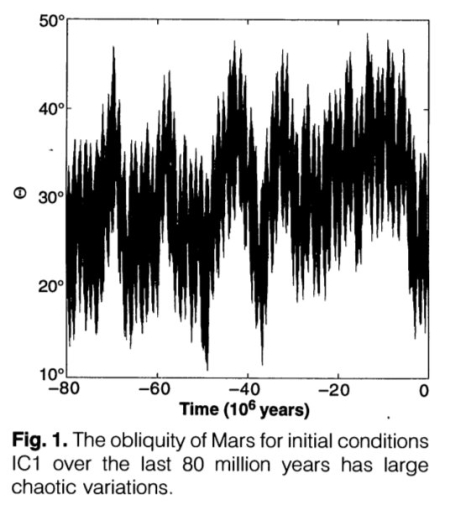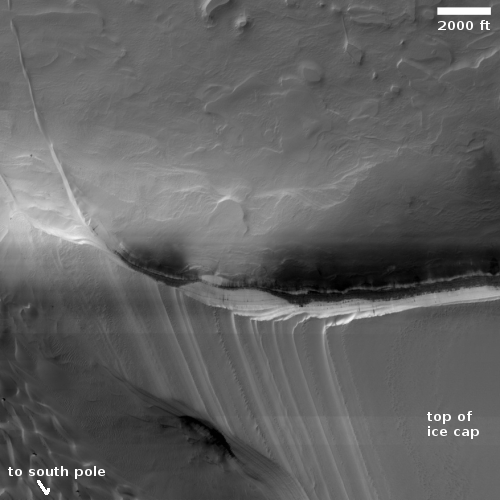The layers of Mars’ north pole icecap
Cool image time! The photo to the right, rotated, cropped, and reduced to post here, was taken on April 1, 2021 by the high resolution camera on Mars Reconnaissance Orbiter (MRO). It shows the high cliff edge of the Martian north polar ice cap, and was taken as part of the springtime monitoring for the numerous avalanches that fall from the icecap’s steep edge every spring.
This particular cliff is probably about 1,000 feet high. I cannot tell if the image captured any avalanches on the very steep north-facing cliff. What struck me about this image however was the terraced layers so visible on the west-facing scarp. You can clearly count about eleven distinct and thick layers, each forming a wide ledge.
Each layer represents a different climate epoch on Mars when the ice cap was growing, with new snow being deposited.

The graph to the right, taken from this paper [pdf], shows how the rotational tilt of Mars, its obliquity, is believed to have shifted over the past 80 million years, that tilt shifting from as low as 11 degrees to as much as 47 degrees.
Scientists believe that when the tilt is low, the poles are the coldest places on Mars. At that time, these layers would be growing as the ice in the planet’s mid-latitudes sublimates into the atmosphere to fall as snow on the polar icecaps.
When the planet’s tilt was as high as 47 degrees, the mid-latitudes become the coldest region on Mars, and the ice on these polar layers begins to sublimate away to fall as snow in the mid-latitudes. The ice however did not all disappear, probably because dust had been deposited on top to protect it. When the obliquity shifted again and snow began falling at the pole, a new layer began to form on top of the dirty top of the previous layer, creating the layers we see today.
This image shows about eleven thick layers, each probably representing an epoch of at least several hundred thousand years. The retreat seen for each new layer probably tells us something about the overall loss of water in Mars’ atmosphere.
Other places along the icecap’s edge typically show many more layers, illustrating that the number of climate cycles on Mars have been very numerous over the eons. In order to get a clear picture of the geological history of all of Mars we will need to document these cycles precisely, a documentation that will not be possible until we can drill a number of core samples into this icecap so that we can date each layer.
Once we can do that, much of the geology we see here as well as in the mid-latitudes will suddenly become decipherable. The guesswork that planetary geologists are now making about what they see across all of the icy surface of Mars above 30 degrees latitude will change to solid knowledge and some clarity.
On Christmas Eve 1968 three Americans became the first humans to visit another world. What they did to celebrate was unexpected and profound, and will be remembered throughout all human history. Genesis: the Story of Apollo 8, Robert Zimmerman's classic history of humanity's first journey to another world, tells that story, and it is now available as both an ebook and an audiobook, both with a foreword by Valerie Anders and a new introduction by Robert Zimmerman.
The print edition can be purchased at Amazon or from any other book seller. If you want an autographed copy the price is $60 for the hardback and $45 for the paperback, plus $8 shipping for each. Go here for purchasing details. The ebook is available everywhere for $5.99 (before discount) at amazon, or direct from my ebook publisher, ebookit. If you buy it from ebookit you don't support the big tech companies and the author gets a bigger cut much sooner.
The audiobook is also available at all these vendors, and is also free with a 30-day trial membership to Audible.
"Not simply about one mission, [Genesis] is also the history of America's quest for the moon... Zimmerman has done a masterful job of tying disparate events together into a solid account of one of America's greatest human triumphs."--San Antonio Express-News
Cool image time! The photo to the right, rotated, cropped, and reduced to post here, was taken on April 1, 2021 by the high resolution camera on Mars Reconnaissance Orbiter (MRO). It shows the high cliff edge of the Martian north polar ice cap, and was taken as part of the springtime monitoring for the numerous avalanches that fall from the icecap’s steep edge every spring.
This particular cliff is probably about 1,000 feet high. I cannot tell if the image captured any avalanches on the very steep north-facing cliff. What struck me about this image however was the terraced layers so visible on the west-facing scarp. You can clearly count about eleven distinct and thick layers, each forming a wide ledge.
Each layer represents a different climate epoch on Mars when the ice cap was growing, with new snow being deposited.

The graph to the right, taken from this paper [pdf], shows how the rotational tilt of Mars, its obliquity, is believed to have shifted over the past 80 million years, that tilt shifting from as low as 11 degrees to as much as 47 degrees.
Scientists believe that when the tilt is low, the poles are the coldest places on Mars. At that time, these layers would be growing as the ice in the planet’s mid-latitudes sublimates into the atmosphere to fall as snow on the polar icecaps.
When the planet’s tilt was as high as 47 degrees, the mid-latitudes become the coldest region on Mars, and the ice on these polar layers begins to sublimate away to fall as snow in the mid-latitudes. The ice however did not all disappear, probably because dust had been deposited on top to protect it. When the obliquity shifted again and snow began falling at the pole, a new layer began to form on top of the dirty top of the previous layer, creating the layers we see today.
This image shows about eleven thick layers, each probably representing an epoch of at least several hundred thousand years. The retreat seen for each new layer probably tells us something about the overall loss of water in Mars’ atmosphere.
Other places along the icecap’s edge typically show many more layers, illustrating that the number of climate cycles on Mars have been very numerous over the eons. In order to get a clear picture of the geological history of all of Mars we will need to document these cycles precisely, a documentation that will not be possible until we can drill a number of core samples into this icecap so that we can date each layer.
Once we can do that, much of the geology we see here as well as in the mid-latitudes will suddenly become decipherable. The guesswork that planetary geologists are now making about what they see across all of the icy surface of Mars above 30 degrees latitude will change to solid knowledge and some clarity.
On Christmas Eve 1968 three Americans became the first humans to visit another world. What they did to celebrate was unexpected and profound, and will be remembered throughout all human history. Genesis: the Story of Apollo 8, Robert Zimmerman's classic history of humanity's first journey to another world, tells that story, and it is now available as both an ebook and an audiobook, both with a foreword by Valerie Anders and a new introduction by Robert Zimmerman.
The print edition can be purchased at Amazon or from any other book seller. If you want an autographed copy the price is $60 for the hardback and $45 for the paperback, plus $8 shipping for each. Go here for purchasing details. The ebook is available everywhere for $5.99 (before discount) at amazon, or direct from my ebook publisher, ebookit. If you buy it from ebookit you don't support the big tech companies and the author gets a bigger cut much sooner.
The audiobook is also available at all these vendors, and is also free with a 30-day trial membership to Audible.
"Not simply about one mission, [Genesis] is also the history of America's quest for the moon... Zimmerman has done a masterful job of tying disparate events together into a solid account of one of America's greatest human triumphs."--San Antonio Express-News



Almost like steps…
Fabulous image!
I always like seeing new information about the ice caps of Mars.
Has there ever been, or is there any present proposal, for mars landers to probe those regions?
Brad: In a word, no. We had a lander many years ago that tried to land near the poles, Mars Polar Lander, but the mission failed.